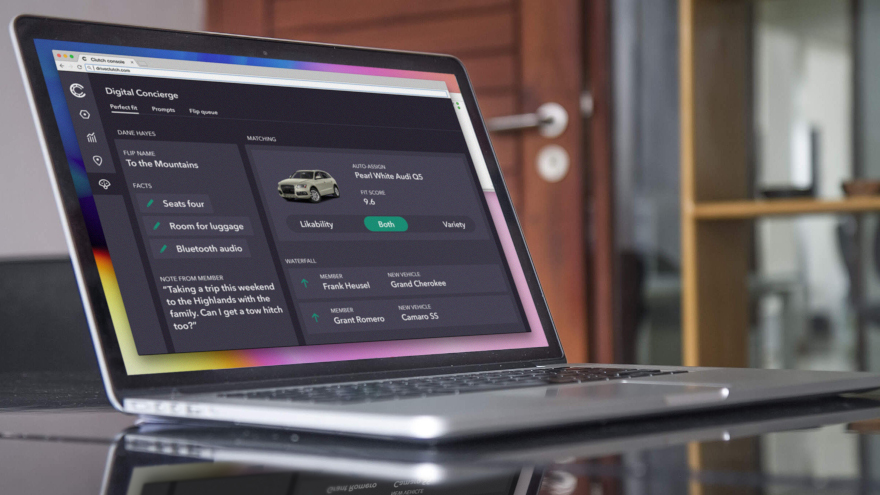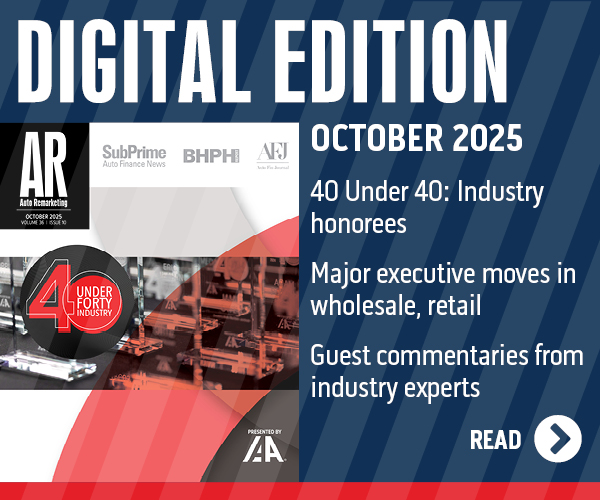3 unsung opportunities in vehicle subscription programs

Image courtesy of Clutch Technologies.
By subscribing, you agree to receive communications from Auto Remarketing and our partners in accordance with our Privacy Policy. We may share your information with select partners and sponsors who may contact you about their products and services. You may unsubscribe at any time.
ATLANTA –
During a wide-ranging and in-depth conversation with a group of reporters gathered at its headquarters, executives with Clutch Technologies played the part of myth-busters, sharing data and analysis they say helps dispel some of the misconceptions around vehicle subscriptions.
Among those: that it is not a product for the mass market, that it would cannibalize vehicle ownership, that it isn’t profitable (or able to be profitable) and demands tons of investment into inventory. Another, that subscriptions are often put in the same bucket as car-sharing, ride-hailing and so forth.
The conversation also uncovered what some yet-to-be fully tapped potential in subscription programs.
As mobility and technology continues to transform the auto industry, the opportunities in vehicle subscription are, perhaps, more than meets the eye.
Here are just a few in which there may be some potential.
Loaner vehicles moonlighting in subscription fleets
“I actually think that loaner car programs, properly evolved, are really the mobility fleets for these dealers in the future,” said Vince Zappa, president at Clutch.
Subscribe to Auto Remarketing to stay informed and stay ahead.
By subscribing, you agree to receive communications from Auto Remarketing and our partners in accordance with our Privacy Policy. We may share your information with select partners and sponsors who may contact you about their products and services. You may unsubscribe at any time.
Granted, it could be a while for the “nuances” and state-by-state intricacies to be ironed out. But the benefit of using loaner cars in subscription fleets is a sentiment Clutch said it has heard back from customers, including dealers and automakers.
A dealer might typically have 50 to 100 loaner cars, with the utilization usually happening during the week, said John Phelps, who is Clutch’s vice president of strategy and growth. The data shows that an average repair order takes between three to five hours and the average time a loaner car is used is between 2.5 and three days, he said.
“So, you have this unused capacity that’s disappearing, but more importantly is you just simply have the weekends, where (loaner) cars then sit idle,” Phelps said. “And so, I think that’s where you start to see power of these things coming together.”
He added: “If you have a big electric vehicle rollout coming and you need to pair an SUV or a larger range anxiety-reducing ICE vehicle, a vehicle on-demand on the weekends is typically when that car’s needed. And so, there’s just some very nice synergies that are basically already in place that allow these OEMs and franchised networks to accelerate into some of these areas of mobility.”
Typically, things like loaner car and courtesy rental programs have been costs in terms of service P&L, Phelps said.
Using those cars in subscription fleets, as well, “turns it into a profit center,” he said.
Clutch is already seeing some dealers become more deliberate in terms of deciding which specific vehicle is provided to a customer who needs a loaner car.
As an example, a forward-thinking dealer wouldn’t just choose a given car to hand out as a loaner because the key happened to be sitting on the desk next to them, Phelps said.
That specific car might better serve the dealer that day(s) in the subscription fleet. Another car might be of better service as a loaner that day.
It’s all about optimizing the use of the fleet. And Clutch’s software is helping dealers make those kinds of decisions, he said.
In related news, Clutch entered a partnership in November with TSD, which provides fleet management software tools to help manage rental and loaner car fleets.
The news release announcing the partnership points out that dealers and automakers (many of which are shared customers of the two companies) are, indeed, transitioning loaner car fleets to mobility fleets.
With TSD’s loaner management platform being integrated into Clutch’s mobility software, dealers and automakers can utilize service loaners for pickup and delivery service, done through intelligence workflow and scheduling tools; provide a look into fuel and toll charges on service loaners via telematics services; and bring loaner cars into mobility programs (like subscriptions).
“Technology is enabling new ways for the automotive industry to provide vehicle access and experiences to consumers,” Zappa said in the November release.
“Together with TSD, we will enable better retail and service experiences, new operational capabilities, and unlock opportunities for dealers to monetize service loaner fleets in mobility.”
Using subscriptions as extended test drives
Some of Clutch’s customers have used the concept of vehicle subscription to help generate more test drives, Zappa said.
Say a consumer comes into the dealership and wants to buy an SUV, but is unsure of which exact model he or she wants.
The dealer would then sign the customer up for the subscription program and have him or her try out various models and then make a purchase decision after that process is done.
“We’re actually going to productize that,” Zappa said. “We think there’s a lot of inefficiency.
“There’s two things we want to do: One is to remove inefficiency in the dealership related to the test drive process,” he said. “And No. 2, we think it just offers a way for the dealer to close business better.”
Subscriptions at independent dealers
It would appear that the vehicle subscription market has largely been the domain of franchised dealers and automakers. However, there’s a wealth of opportunity on the independent and buy-here, pay-here, side as well.
“We’re getting a lot of interest from those folks, now that we have the capability to launch single VIN (subscriptions),” said Taylor Sandusky, who is head of business development at Clutch. “There’s clearly a market need for that.”
In fact, two independent dealers are set to join the Clutch platform in July.
Separate from the Clutch discussion, DriveItAway chief executive officer John Possumato finds that subscription works best on pre-owned.
What his company offers the subprime and buy-here, pay-here space — which he describes as “car-sharing for ride-sharing with a path to ownership” — isn’t too different than subscriptions, Possumato said via email.
He contends, “the only difference is our target audience now drives for Uber or Lyft part time and pays for a month, but in daily increments, with the right (but not the obligation) of converting into a purchase when and if they fit the parameters.”
And demand is growing, he said.
“We have been asked by our dealers, who see an opportunity, to extend this same service to non-ride-share drivers, on the observation that renting or a subscription opportunity as a precursor to ownership (never having to come up with a down payment at initiation and having the right but not the obligation to buy) is something that many subprime buyers want,” Possumato said. “More like a fintech/subscription instrument, without any desire (or financial need) to drive for Uber or Lyft.
“To me, at this point, subscriptions are the one area that almost only works for used vehicles, which means it is the one ‘equalizer’ for independent dealers, as they do not have access to new (or slightly new) vehicles like the franchise guys,” he said. “Ironically, although this is the case, surprising to me we have many more franchise dealers asking to use our platform than independents.”


